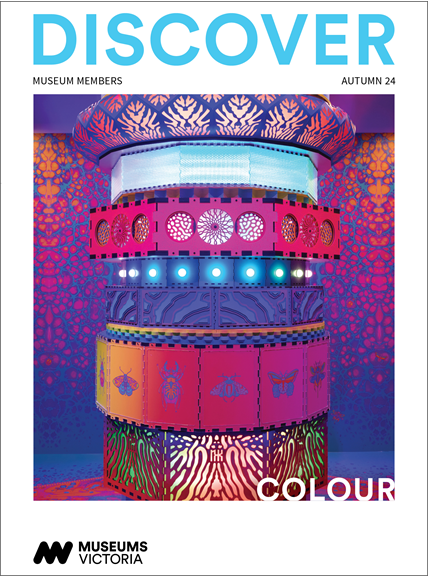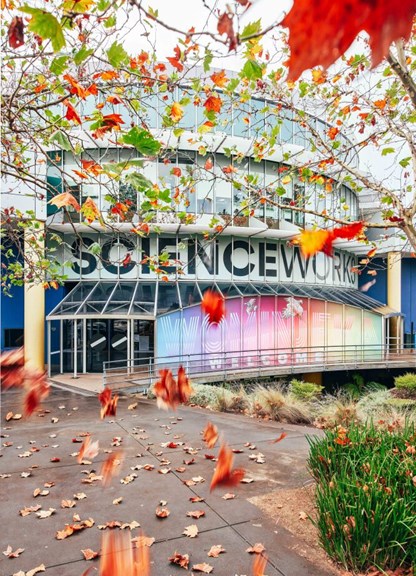Discover Magazine: Autumn 2024
Welcome to a new issue of Discover, featuring interviews with Museums Victoria’s experts.
We hope you enjoy your member exclusive behind-the-scenes look at the wonderful stories the museum has to offer.
The secret that trees don’t want you to know!
Autumn leaves are orange because they’re not green anymore.
Well, that’s pretty obvious right? But it’s true. When the green in our leaves disappears, it reveals the beautiful yellows and oranges hiding underneath. But what causes the magnificent transformation of deciduous (leaf-losing) trees as the weather cools? Let’s take a journey through the season and find out.
First, we need to understand why they’re green.
Feeling green?
Leaves are absolutely full of chlorophyll. Chlorophyll is a green pigment with a vital job: photosynthesis. Using photosynthesis, plants absorb sunlight and transform it into sugars that keep the plant alive. Plants use their leaves as perfect sun-catchers, stretching their broad, green surfaces towards the sun and soaking up the warm, rich sunlight. Chlorophyll absorbs the light and kicks off the reactions for photosynthesis.
So why is it green? Chlorophyll absorbs red and blue light from the sun, leaving green as a leftover to be reflected out and to our eyes. Lucky for us, this reflected green light gives us lush verdant forests, rolling emerald meadows, and soft green lawns.
Orange you glad to see me?
It’s not easy being green, especially as the weather gets colder. Cooler weather and shorter days signal to trees to change out of their summer greenery and don an autumn outfit of golden yellows and warm oranges.
A little-known secret? The trees have been wearing their autumn colours the whole time.
As the nights stretch longer, chlorophyll in the leaves starts to break down. Yet green is not the only pigment in a plant’s leaves. As the green vanishes, it reveals carotenoids. Carotenoids are stunning pigments of yellow and orange, usually hidden beneath the overwhelming green of chlorophyll. We see carotenoids in orange and yellow fruit, such as pumpkins and corn.
Red-y for winter
Sure, carotenoids give us stunning orange and yellow leaves. But what about red? Some trees—like red maples—shed their green to reveal deep, fiery crimsons. There’s another player in the game: Anthocyanins.
As the weather continues to cool, trees form seals at the base of their leaves using a compound called abscisic acid. This barrier essentially strangles the leaf, preventing water and nutrients from reaching it until the leaf eventually drops off.
Some sugars remain trapped inside the leaf as the seal forms. These excess sugars are the reason for the development of anthocyanins, pigments responsible for red and even purple colours in autumn leaves.
At the end of the rainbow
The beautiful transformation of deciduous trees ends with a tree stark and barren of its leaves. But why all this fuss about losing leaves?
Winters are cold, and leaves are expensive.
Hardy trunks and roots can withstand the chill, but soft and delicate leaves are not so resolute. The tree needs plenty of energy and water to keep its leaves alive, but if a dry winter calls for conserving water, the tree will ‘prefer’ to store its energy. Like the gym membership you swore you’d use, keeping leaves alive is just an unnecessary winter expense.
Before a tree drops its leaves, it tries to conserve and regain as much energy is possible. The chlorophyll doesn’t just disappear, it is reclaimed as its energy is absorbed back into the tree.
As frustrated neighbours rake up the leftovers of summer and children play in piles of autumn leaves, the tree lives off its stores of summer energy. When the weather warms up, the tree starts all over again, creating a fresh batch of young, green leaves to continue the colourful cycle.
Carotenoids don’t just colour plants! Find our Birds of a coloured feather article in your copy of Discover to learn more.
For kids: Make a secret message with colour
Science experiment: Colourful walking water
Science experiment: Colourful walking water
Be a scientist and record your observations in this colourful science experiment you can try at home.

